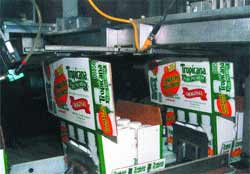Wrapping up performance
March 11, 2015
|
The wraparound tray packer, which packs product in either trays or full-wraparound cartons, is designed to handle a wide range of products and case sizes. |
Everyone should have the opportunity to enjoy the special flavor and quality of freshly squeezed orange juice and to taste Florida's sun on their palate. With this philosophy in mind, Anthony Rossi founded Tropicana in 1947. Today, Tropicana Products, Inc., with headquarters in Bradenton, FL, is a global manufacturer and supplier of a range of fruit juices. Rossi laid the foundation for these beverage in 1954, when he developed a pasteurization process for orange juice. For the first time, it was possible to offer the consumer the fresh taste of orange juice made from 100-percent fruit. The product was not-from-concentrate, in a "ready-to-serve" package. The Tropicana Pure Premium™ brand rapidly became the flagship of this American company.
Since then, Tropicana has achieved a worldwide pole position in the field of fruit-juice-based beverages, with brands like Tropicana Pure Premium, Tropicana Season's Best, Dole Juices and Tropicana Twister. Today, Tropicana is regarded as one of the leading producers and suppliers of the best-quality fruit juices, with operations in 63 countries.
Quality is the central theme of the Tropicana operation. Special attention is given to process and packaging techniques. Quality measurements are taken daily, weekly, monthly and yearly. Walter Auffinger, maintenance manager of Tropicana, and his team are responsible for ensuring the quality and performance standards of the packaging process. "The guarantee of a high-line efficiency is very important to us," says Auffinger. "The terms 'quality' and 'first-class brand' have been our companions for many decades. Therefore, we must maintain trouble-free processes in production, packaging and logistics." This places special demands on the techniques that are used. For this fruit juice manufacturer, high reliability is also very important. Auffinger continues, "We have packaging machines that run consistently without any problems."
As an example, Auffinger refers to the company's Model PTF-28 wraparound tray packer from Kisters Kayat, Inc., which has a proven, consistent and reliable performance record of more than 90 percent, and has reached values of more than 100 percent, several times. This performance also covers peaks in a daily production time of 10 hours without any problems. The machine packs glass, metal and plastic containers at speeds up to 32 cases/min, accommodating both loose and prepackaged containers. It handles round and nonround containers in a large range of sizes, from less than 12 oz to 3 L. Gentle product handling for all products is another feature of the PTF-28. In the packing process, pre-arranged groups, or lanes, of product descend only 1 in. to the flat tray or case blank. The side flaps are folded, and the pack is then indexed through the machine for gluing and side compression.
The machine packs product in either trays or full-wraparound cases, each of which has its own advantages. Packing product in trays allows processors to reduce the use of corrugated material and minimize the costs of secondary packaging. Packing product into full-wraparound cases increases stacking strength, especially important for non-carbonated water in polyethylene terephthalate bottles.
The Model PTF-28 is designed to handle a wide range of products and case sizes, and flexibility and rapid changeover are key features. Machine changeover, involving both product and case blank size, can be accomplished in 30 minutes or less, and secondary packaging can be changed from trays to cases while minimizing production downtime.
A variety of features contribute to these quick and accurate changeovers. PLC controls enable preprogramming with specific settings for different products. Fixed stops guarantee precise setup with no need for fine-tuning to ensure consistent tray packing quality. Quick-release handles assist the nearly tool-less changeover routine. With the use of the positive, non-adjusting changeover format, the first case produced after a changeover will be perfect and the machine will not need fine-tuning, says the machine manufacturer.
Many operating safeguards
The product enters the machine at random, in prearranged groups, or lanes. By means of accumulation pressure, the containers advance into the filling head, which holds the required formation. A flat tray or case blank, having been drawn from the magazine, is in position under the filling head, and the product is moved into place. The tray or blank, with the product in place, is lowered through the forming section into the indexing pocket chain. Hot-melt adhesive is applied as the case is indexed forward into the case-squaring compression section. The case is inspected for unglued flaps when it exits onto the discharge roller conveyor. In the event of a downstream stoppage, the machine can be brought to the end of cycle within one case length. Should an open case be present at the flap-folding station, the glued flaps will be closed by means of a pneumatic device that is triggered both by the stoppage and by the presence of the open case. The microprocessor continuously stores and retrieves operational data, including operator information, which is provided by an LCD with two lines of data.
Several safeguards are in place. When the line is running loose containers, a sensor detects fallen containers entering the machine. If the incoming product falls below the minimum required to fill the grid, the grid will not release while the infeed conveyor continues to run. When the supply of product is restored, the grid release will automatically restart. If a jam occurs at the transfer into the forming area, or should the carton blank fail to feed in proper sequence, the machine will automatically stop.
More information is available:
Tray packer: Kisters Kayat, Inc., 386/424-0101. Circle No. 215.
About the Author(s)
You May Also Like



